
Apricot, mirabelle, plum and prune
disease models
Rust disease
Pathogen
The fungal pathogen Tranzschelia discolor infects plants of the genus Prunus, including almond, apricot, cherry, peach, nectarine, plum, and prune. The fungus is classified into specialized forms based on its host: T. discolor f. sp. persicae on peach, T. discolor f. sp. dulcis on almond, and T. discolor f. sp. domesticae on prune.
The pathogen undergoes multiple spore stages and requires two distinct hosts (alternate hosts) to complete its life cycle. In California, the only confirmed alternate host is Anemone coronaria (Ranunculaceae). The different spore types include urediniospores, teliospores, basidiospores, and aeciospores, though only urediniospores and teliospores occur on Prunus species.
Rusty brown, single-celled urediniospores are produced on peach and can cause secondary infections, leading to repeated cycles of spore production and reinfection, ultimately resulting in epidemic outbreaks. Teliospores, which develop later in the season on peach, do not reinfect Prunus species. Instead, they overwinter and germinate in the following season, producing basidiospores that infect the alternate host, A. coronaria.
Aeciospores produced on A. coronaria can only infect Prunus species, initiating the first cycle of urediniospore production in spring. However, because A. coronaria is rare in stone fruit orchards, it is unlikely to be the primary infection source. Instead, the fungus likely overwinters as mycelium in infected fruit wood from the previous season. In spring, these infections develop into twig cankers, serving as the primary inoculum source each year. Urediniospores from twig cankers infect leaves, where additional spores form in lesions. Under favorable conditions, the disease can reach epidemic levels.
Symptoms
Common symptoms of the disease include twig cankers, leaf lesions, and fruit lesions. However, not all symptoms may appear in every growing season.
Twig cankers are the first symptoms to appear in spring, developing after petal fall during fruit formation on one-year-old wood. These cankers manifest as blisters and longitudinal splits in the bark.
The infection begins with water-soaked lesions that swell and rupture the epidermal tissue of the twig. Cankers are typically found on the upper, reddish side of the twig. Within a few days (depending on temperature), the cankers mature and produce rusty brown, powdery masses of specialized spores called urediniospores. These urediniospores are spiny and sharply constricted at the base. By the end of the season, old cankers may still be visible, though they may persist into the following season, they no longer produce viable spores.
Leaf lesions usually develop after twig cankers form in spring and may continue to appear until autumn. Severe infections can lead to defoliation, especially when multiple lesions are present on a single leaf. The first infected leaves are typically located near the twig cankers, which serve as the primary source of inoculum. Initially, lesions appear as pale yellowish-green spots visible on both leaf surfaces. As they progress, they become bright yellow and angular, eventually developing necrotic centers. On the lower leaf surface, numerous spore pustules (uredinia) appear, turning rusty brown as they produce powdery masses of urediniospores. By the end of the season, leaf lesions may darken to brown or black and begin producing two-celled teliospores. These lesions remain small, angular, and rusty brown in color.
Fruit lesions develop later in the growing season, following the appearance of leaf symptoms. Initially, small brownish spots with green halos form on mature, yellow fruits. As the fruit ripens and reddens, the halos transition to a greenish-yellow color. Multiple infections can develop on a single fruit, creating entry points for secondary fungal pathogens such as Monilinia, Colletotrichum, Alternaria, and Cladosporium, leading to further fruit decay.
FieldClimate model
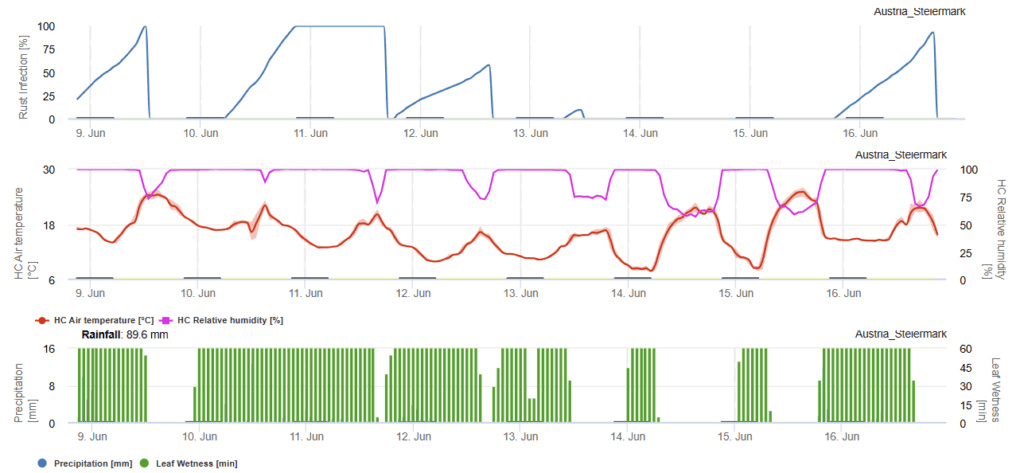
Spores of the fungal pathogen Tranzschelia discolor germinate across a wide temperature range, from 5°C to 30°C, with an optimal range of 15°C to 25°C under wet conditions. Under controlled conditions, the ideal combination of wetness duration and temperature for infection was found to be between 18 and 36 hours at 15°C to 20°C. The severity of the disease increases when rainfall occurs in late spring and summer. In severe cases, trees can experience rapid defoliation due to heavy rust infections.
To assess the risk of rust infection, we calculate a critical period based on precipitation, leaf wetness, and temperature. When the infection curve reaches 100%, it indicates that optimal conditions for rust infection have been met in the orchard. At this point, preventive plant protection measures should be implemented to mitigate the risk of severe disease development.
Literature
Adaskaveg JE, Soto-Estrada, A, Förster, H, Thompson, D, Hasey, J, Manji, BT, Teviotdale, B. (2000). Peach rust caused by Tranzschelia discolor in California. University of California. Agriculture and Natural Resources.
Monilinia laxa
Pathogen
Monilinia laxa, the causative agent of brown rot in stone fruits, follows a cyclical pattern that ensures its persistence and propagation. The fungus overwinters in infected plant tissues, such as twigs, branches, old flower parts, or mummified fruits. In the spring, it produces asexual conidia on these infected plant debris. Additionally, sexual propagative structures called apothecia develop on fallen fruits on the ground, producing ascospores. Both conidia and ascospores are disseminated by wind and rain, leading to new infections in blossoms and young shoots.
Environmental conditions significantly influence the infection process of Monilinia laxa. The fungus thrives in warm, wet weather, with optimal infection temperatures ranging between 15°C and 25°C (59°F to 77°F). Conidia begin to develop on infected plant debris once temperatures reach 4°C (40°F), and infections occur when temperatures exceed 10°C (50°F). High humidity and wet conditions facilitate the spread and germination of spores, making rainy periods particularly conducive to disease development.
Symptoms
The initial symptoms of Monilinia laxa infection manifest as blossom blight, where infected flowers wilt, turn brown, and may cling to the tree. This blight can extend to twigs and branches, leading to the formation of cankers—sunken, necrotic areas on the wood. Under humid conditions, ash-gray to brown spore masses can form on diseased flowers and twig cankers, serving as sources of secondary inoculum.
As the growing season progresses, the fungus can infect developing fruits, leading to brown rot. Infected fruits exhibit brown, rapidly expanding lesions, often covered with grayish spore masses under humid conditions. These fruits may become mummified and remain attached to the tree, serving as reservoirs for the pathogen. The disease can cause significant pre- and post-harvest losses, especially in warm, wet seasons, affecting both yield and fruit quality.
FieldClimate model
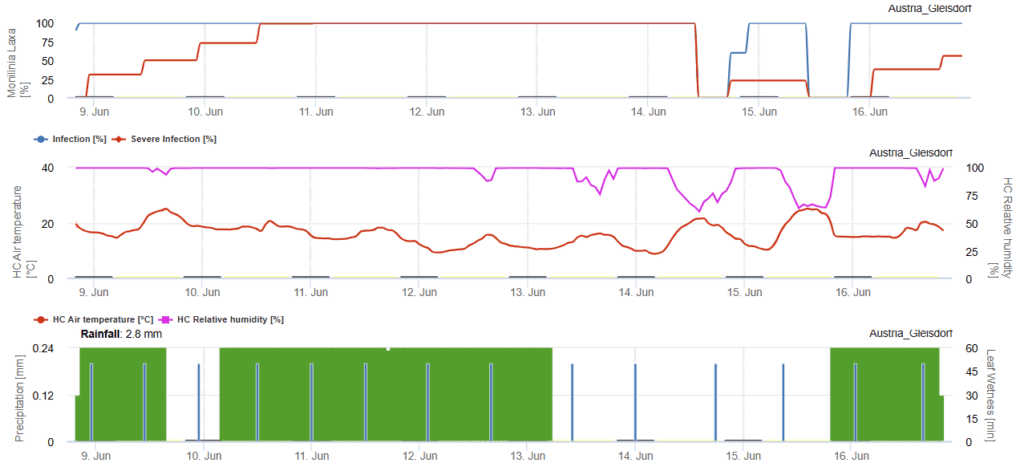
Sensors needed:
- Air temperature
- Leaf wetness
- Relative humidity
- Precipitation
The graph illustrates the optimal conditions for Monilinia infections in orchards, based on factors such as leaf wetness, temperature, and relative humidity. Monilinia laxa is well adapted to relatively low temperatures in spring and can cause infections at temperatures as low as 5°C, even with a short period of leaf wetness. A 100% infection level on the graph represents the most favorable conditions for the fungus to penetrate plant tissues and initiate infection.
To support disease management, curative plant protection measures should be considered. The graph provides two severity classes—infection and severe infection—based on factors such as fruit variety, orchard history, and the experience of farmers. These classifications help guide decision-making for effective disease control.
Literature
- Casals, C. (2010). Effect of temperature and water activity on in vitro germination of Monilinia spp. Journal of Applied Microbiology.
- UC IPM. (n.d.). UC Management Guidelines for Brown Rot Blossom Blight on Almond. Victoria, Department of Environment and Primary Industries. (n.d.). Brown-rot of stone fruits.
Monilinia spp.
Pathogen
The brown rot pathogen, Monilinia spp., affects stone fruits through a lifecycle that begins with overwintering in mummified fruits and twig cankers. As temperatures rise in spring, the fungus produces spores that infect blossoms and young shoots, leading to blossom blight and twig cankers. These infections serve as sources of inoculum for fruit infections later in the season. Mature fruits become increasingly susceptible to brown rot, especially under warm, wet, or humid conditions, which favor rapid disease progression. Injuries to fruit, such as those caused by insects or hail, further increase susceptibility. Effective management includes cultural practices like removing mummified fruits and cankered twigs, as well as chemical controls involving fungicide applications during critical periods of bloom and pre-harvest.
Symptoms
Monilinia spp. manifests through several distinct symptoms. During spring, infected blossoms wilt, turn brown, and may become covered with grayish-tan spore masses, often remaining attached to twigs and serving as sources of secondary inoculum. The infection can extend into twigs, leading to the formation of small, gummy cankers that may girdle and kill the affected shoots. On ripening fruit, initial symptoms appear as small, circular brown spots that rapidly enlarge under favorable conditions, potentially causing the entire fruit to rot within two days. These rotting areas often develop tan to gray spore masses. Affected fruits typically shrivel, turn brown to black, and may either drop to the ground or remain mummified on the tree, contributing to the disease’s persistence and spread.
FieldClimate model
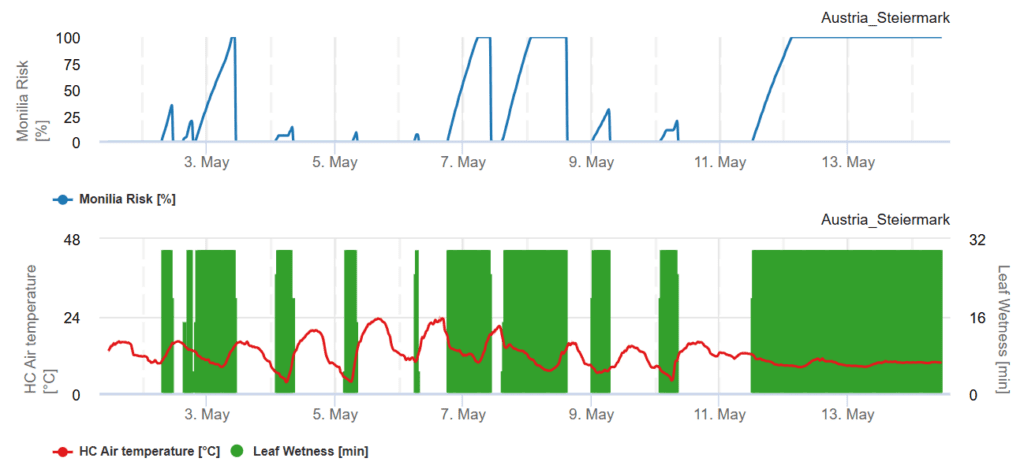
Sensors needed:
- Air temperatures
- Leaf wetness
The curve at 100% indicates optimal conditions for a Monilia infection in orchards. The calculations are based on leaf wetness, temperature and relative humidity.
Monilia spp. is well adapted to relatively low temperatures during spring and causes infections at temperatures as low as 5°C within a very short period of wetness duration. 100% infection on the graph indicates optimal conditions for the fungus to enter the plant tissue and cause infections. Curative plant protection measurements have to be taken into account.
Literature
- Peter, K. A. (2024, June 19). Stone fruit disease – Brown rot. Penn State Extension. https://extension.psu.edu/stone-fruit-disease-brown-rot
- Biggs, A. R. (2016). Brown rot of stone fruits. Ohioline, Ohio State University Extension. https://ohioline.osu.edu/factsheet/plpath-fru-29
Shot hole
Pathogen
The shot hole fungus overwinters in infected buds and can infect leaves, stems, and fruits during cold, rainy periods in spring and autumn. Rainfall is essential for the fungus to spread and infect healthy plant tissues.
The fungus can persist for several years in cankers or buds of infected twigs. Under favorable conditions, it continues to grow, even during winter. In spring, conidia are dispersed by rain to flowers and young leaves, initiating new infections. During unfavorable conditions, such as dry weather, conidia remain viable for several months. Rain is necessary for spore dispersal, while humid conditions are required for germination. The fungus can grow at temperatures above 2°C.
When moisture is continuous for at least 24 hours and temperatures exceed 2°C, infection can occur. As temperatures rise during the growing season, shorter moisture periods are required for germination—for example, only six hours at 25°C. Spores primarily spread through splashing water and can remain viable for months in dry conditions. Under optimal conditions, spores are produced from infected buds and stem lesions throughout the growing season. Most peach, nectarine, apricot, and almond cultivars are highly susceptible, whereas cherry and plum are less affected, displaying leaf and fruit symptoms only when extended moisture periods occur in late spring and early summer.
Symptoms
Infected leaves develop small brown spots with reddish margins, approximately 1 mm in diameter. These spots expand into larger circular lesions, around 3 mm in diameter. As the disease progresses, the affected areas dry out and fall from the leaf, creating a shot-hole appearance. Infected twigs display distinct brown margins with a necrotic center that does not drop out but instead exudes large amounts of gum. Additionally, lignification of infected twigs is hindered, and the lesions gradually develop into cankers. In severe cases, the disease may lead to premature defoliation of the tree.
On fruits, the infection initially appears as small, circular, deep-purple spots. As the disease progresses, symptoms vary depending on the fruit type. On apricots, the spots become brown, raised, and rough, giving the fruit a scabby texture. In peaches and nectarines, the scabs deepen into pronounced indentations. Infected fruits often develop gummy spots, and in severe cases, cracks may form in the skin.
FieldClimate model

Sensors needed:
- Air temperature
- Relative Humidity
- Leaf wetness
- Precipitation
Favorable infection periods for the disease “shot hole” are determined based on precipitation, leaf wetness, relative humidity, and temperature. Three levels of infection severity are assessed. Weak infections can begin under conditions of high relative humidity and warm temperatures. Moderate and severe infections are triggered by rain events and become more severe with prolonged leaf wetness and warm temperatures. A 100% infection rating on the scale indicates optimal conditions for fungal infection in the field.
Plant protection measures should be implemented based on the severity of the infection, taking into account past experience, orchard history, and the susceptibility of the fruit variety. Appropriate actions should be considered for light, moderate, or severe infection levels to minimize disease impact.
Literature
- UC IPM. (n.d.). Shot Hole Disease / Peach / Agriculture. University of California Agriculture and Natural Resources. Retrieved from https://ipm.ucanr.edu/agriculture/peach/shot-hole-disease/
- Utah State University Extension. (n.d.). Coryneum or Shothole Blight. Retrieved from https://extension.usu.edu/planthealth/research/coryneum-or-shothole-blight
Xanthomonas arboricola
Pathogen
Xanthomonas arboricola is an aerobic, gram-negative bacterium. The bacterium overwinters in the intercellular spaces of the cortex, phloem, and xylem parenchyma of the peach tree. On plum and apricot trees, summer cankers form within one season, developing further in the following spring and serving as a source of inoculum. Additionally, plum buds and fallen leaves act as overwintering sources for the bacterial disease.
In spring, the bacteria begin to multiply, causing the epidermis to rupture—this results in visible lesions known as spring cankers. Inoculum from these cankers is disseminated by rain and wind, infecting healthy plant tissues through stomata. Lesions then develop on the leaves, exuding bacteria and leading to secondary infections.
Summer cankers form in the green tissue of the shoot but are sealed off by a periderm layer and dry out during the summer, reducing bacterial viability. Therefore, summer cankers in plum and peach trees are not significant overwintering sites or sources of initial infection for the following season. Generally, late-season infections of shoots—occurring during autumn rains and leaf fall—serve as the primary inoculum source for the following spring.
Symptoms
On peach leaves, small, pale-green to yellow circular or irregular spots appear initially. These spots enlarge and darken to deep purple, brown, or black. As the disease progresses, the affected areas may drop out, giving the leaves a shot-hole appearance, with a dark ring of diseased tissue left behind. Infected leaves often turn yellow and prematurely drop. On plum fruit, symptoms vary depending on the cultivar, ranging from large, sunken black lesions to small, pit-like lesions.
On peach twigs, spring cankers develop on overwintering twigs and watersprouts before green shoots emerge. Initially, they appear as small, water-soaked, dark blisters (1–10 cm in size), sometimes girdling the twig and causing the death of its upper portion. Below the dead area, where bacteria are present, a dark streak known as “black tip” forms. In plum and apricot trees, cankers are perennial and continue to develop in twigs that are two or three years old.
FieldClimate model
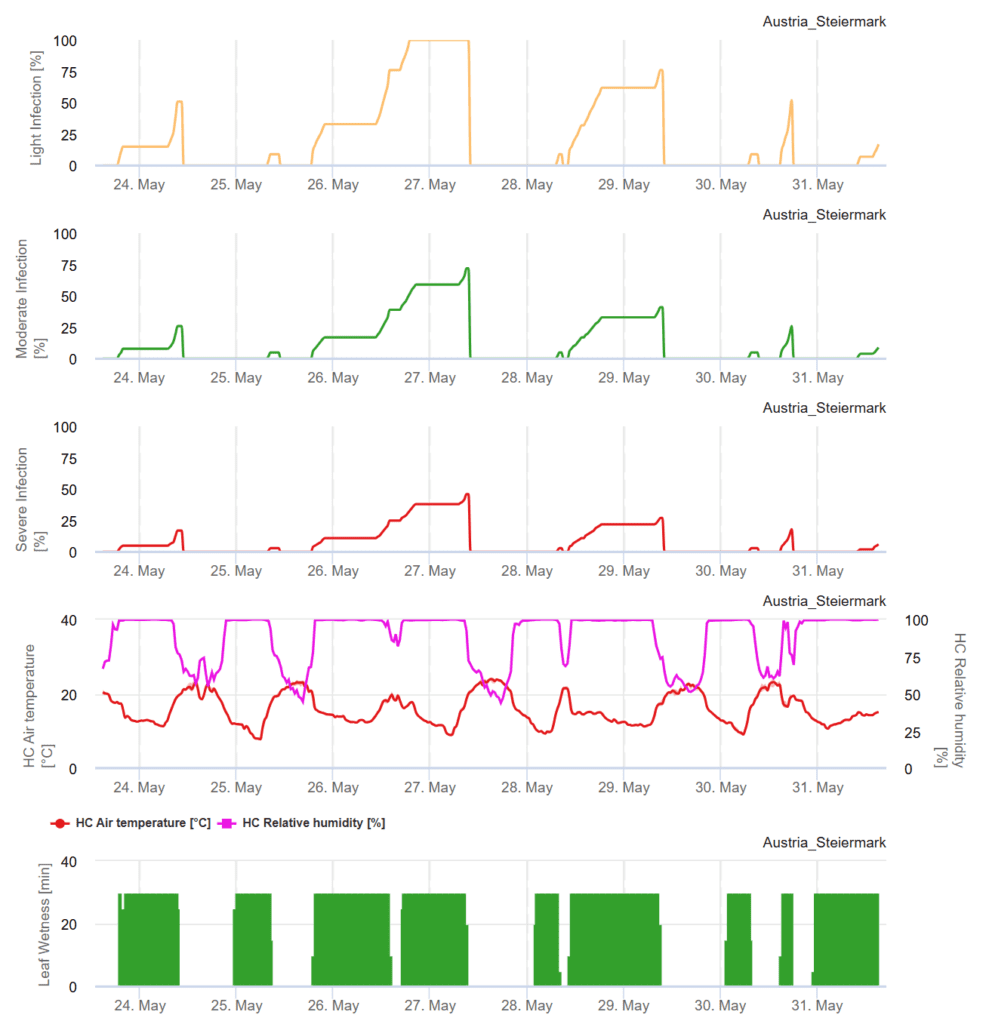
Sensors needed:
- Air temperature
- Relative Humidity
- Leaf wetness
The bacterial disease thrives in warm seasons with temperatures ranging from 10–28°C, as well as in conditions with frequent light rainfall, strong winds, and heavy dew. In orchards, local dispersal occurs primarily through rain splash.
We classify infections into three severity levels: weak, moderate, and severe. The severity to be considered depends on the amount of inoculum present (based on the previous year’s epidemiology), the susceptibility of the variety, and prevailing weather conditions. A value of 100% indicates optimal conditions for bacterial infection.
Literature
- EPPO. (2021). PM 7/064 (2) Xanthomonas arboricola pv. pruni. EPPO Bulletin, 51(3), 468-487. https://doi.org/10.1111/epp.12756
- McManus, P. S., & Jones, A. L. (1995). Bacterial spot of peach and plum. Integrated Pest Management, Michigan State University. https://www.canr.msu.edu/ipm/agriculture/fruit/bacterial_spot_of_peach_and_plum
Taphrina leaf curl
Pathogen
Taphrina deformans, the causative agent of peach leaf curl, overwinters as spores on tree surfaces, including bark and bud scales. In early spring, during bud swell and opening, these spores germinate and infect emerging leaves. Cool, wet weather conditions, particularly warm temperatures accompanied by moisture from rain, dew, or irrigation, are optimal for infection. Conversely, dry weather during bud swell and bud break limits disease occurrence. As leaves mature, they become less susceptible to infection, and secondary infections are rare. The fungus produces spores on infected leaf surfaces, which are dispersed by rain or wind, lodging in bark crevices and bud scales to overwinter and perpetuate the disease cycle in subsequent seasons.
Symptoms
The pathogen induces a range of symptoms in peaches and nectarines. Infected leaves emerge in spring displaying thickening, curling, and distortion, often accompanied by reddish or purple discoloration. As the disease progresses, these leaves may turn yellow or brown and eventually fall prematurely, leading to potential defoliation. Infected shoots can become swollen, stunted, and may die, particularly if the infection is severe. Fruit symptoms include raised, irregular, rough patches, often reddish in color, which can cause premature fruit drop or render the fruit unmarketable. If left unmanaged, repeated infections can weaken the tree, reducing fruit yield and overall vigor.
FieldClimate model
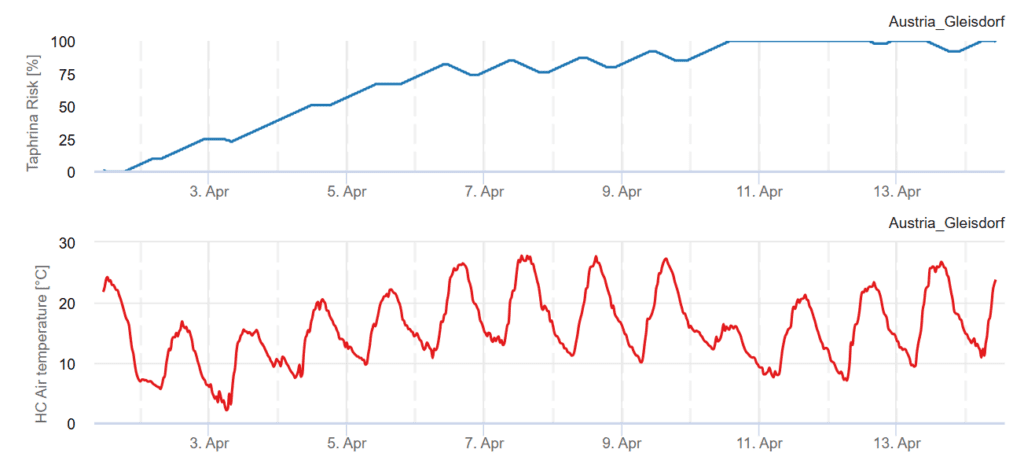
Sensors needed:
- Air temperature
The graph shows risky periods, based on temperature during that time. The pathogen thrives in temperatures between 16 and 27 °C. The graph indicates at 100% that optimal temperatures were met for enough time for an infection event of the pathogen.
Literature
- Biggs, A. R. (2016). Peach leaf curl. Ohioline, Ohio State University Extension. https://ohioline.osu.edu/factsheet/plpath-fru-26
- University of California Agriculture and Natural Resources. (n.d.). Peach leaf curl. UC IPM Pest Notes. Retrieved March 6, 2025, from https://ipm.ucanr.edu/home-and-landscape/peach-leaf-curl/pest-notes/
Powdery mildew
Pathogen
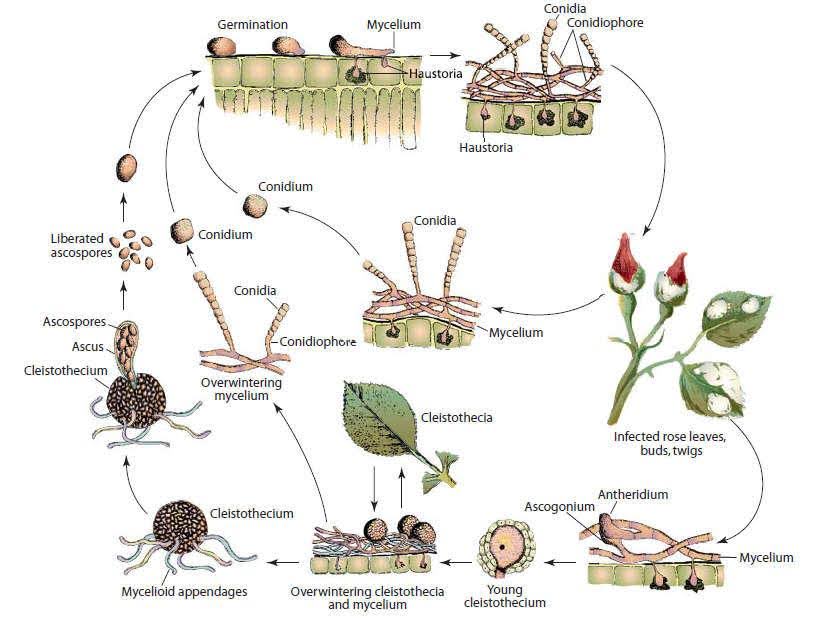
The pathogen is Sphaerotheca pannosa. It overwinters as mycelia in infected buds or cleistothecia and they serve as the primary inoculum.
Conidia (asexual spores) and ascospores (sexual spores) are produced by mycelium and cleistothecium, respectively. They are carried by wind to susceptible plants and once landing, they germinate and produce a germ tube which forms hyphae, spreading the infection. Secondary infections occur mainly via conidia. Those produced by primary and subsequent infections are carried by wind and rain, continuing the infection. Once environmental conditions become harsh, the fungus shifts to sexual reproduction mainly and the cycle repeats.
Symptoms
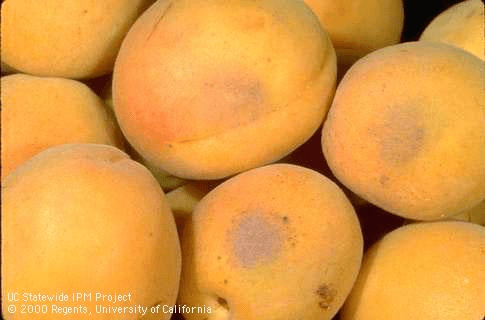
Initially, blisters appear on the affected areas, which are soon covered with white to grayish powdery mycelium and spores. This fungal infection leads to leaf distortion, curling, and premature leaf fall. Buds and flowers are also vulnerable; they may fail to open properly and exhibit discoloration and stunted growth. Additionally, fruits are highly susceptible – they may develop rough, corky spots that turn pink to dark brown on their skin and the epicarp gets leathery and hard.
FieldClimate model
General Sphaerotheca pannosa Risk Model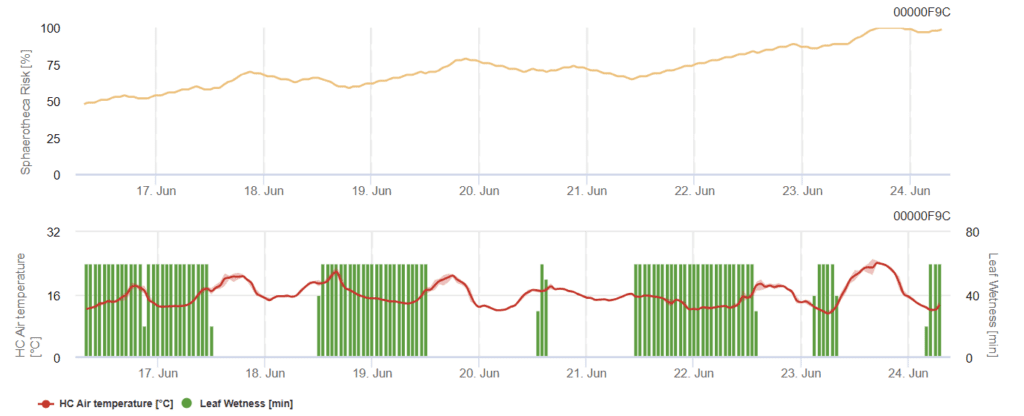
Sensors needed:
- Air temperature
- Leaf wetness
The model considers air temperatures and leaf wetness duration to calculate the risk. The optimum temperature ranges from 21 to 27’c and the disease development gets slower at temperatures above 28’c. Since spores and mycelium are sensitive to extreme heat and direct sunlight, warm moderate temperatures, and shade are generally favorable. No moisture is required for the fungus to establish and grow after infection. Many more conidia are formed in dry conditions than in humid.
A value exceeding 60% indicates a high risk of infection, and plant protection measurements should be considered.
Literature
- Domínguez-Serrano, D., García-Velasco, R., Mora-Herrera, M. E., Salgado-Siclan, M. L., & Gonzalez-Diaz, J. G. (2016). The rose powdery mildew (Podosphaera pannosa). Agrociencia, 50(7), 901-917.
- Mulbrhan, A., Brikity, A., Yohana, S. R., & Danish, S. (2016). Survey of Disease Incidence and Severity of Powdery Mildews on Roses (Rosa Sinensis L.) in Greenhouses in Maisirwa, Eritrea. Asian Journal of Science and Technology, 7(5), 2850-2856.
- Ram, V., & Bhardwaj, L. N. (2004). Stone fruit diseases and their management. In Diseases of Fruits and Vegetables: Volume II: Diagnosis and Management (pp. 485-510). Dordrecht: Springer Netherlands.
- Yarwood, C. E., Sidky, S., Cohen, M. O. R. R. I. S., & Santilli, V. I. N. C. E. N. T. (1954). Temperature relations of powdery miluews. https://ipm.ucanr.edu/home-and-landscape/powdery-mildew-on-fruits-and-berries/pest-notes
Stone fruit scab model
Pathogen
Cladosporium carpophilum, the causative agent of peach scab, primarily overwinters as mycelium in twig lesions on the previous season’s shoots. In the spring, when humidity exceeds 70%, the fungus produces conidia (asexual spores) in these lesions. These spores are disseminated by air movement and splashing water, infecting developing fruits, new shoots, and leaves. Optimal conditions for spore germination and fungal growth occur at temperatures between 18°C and 24°C (65°F to 75°F), with rain and high humidity facilitating infection. Notably, there is a prolonged incubation period of approximately 40 to 70 days before symptoms become visible on the fruit.
Symptoms
The disease manifests as small, olive to black, velvety spots on the fruit, often more severe near the stem end. These lesions can coalesce, leading to larger diseased areas and potential fruit cracking. On twigs and shoots, infections appear as slightly raised, round to oval, brown lesions with purple margins later in the season. While leaf infections are less common, they can occur under favorable conditions. Severe infections may result in reduced fruit quality and yield, underscoring the importance of effective management practices.
FieldClimate Models
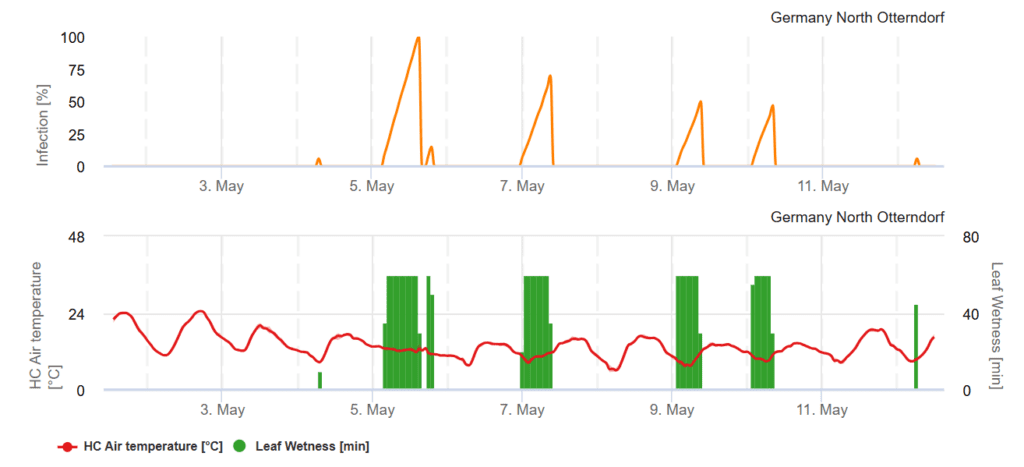
Sensors needed:
- Air temperature
- Leaf wetness
The risk of a Cladosporium carpophilum infection is determined by wet conditions during spring and early summer after petal fall. The disease is usually more serious in low- lying, shady and moist areas with low air movement. Infection curves increase during leaf wetness periods within a temperature range of 7 to 24°C and at a risk of 100% optimal conditions for the fungus to enter the plant tissue have been given. Curative plant protection measurements should be considered after 100% risk.
Literature
- Ellis, M. A. (2016). Scab of peach, nectarine, plum, and apricot. Ohioline. Retrieved from https://ohioline.osu.edu/factsheet/plpath-fru-39
- Garofalo, E. (2020). Peach scab. New England Tree Fruit Management Guide. Retrieved from https://netreefruit.org/stone-fruit/peaches-nectarines/diseases/peach-scab
Recommended equipment
Check which sensor set is needed for monitoring this crop’s potential diseases.
